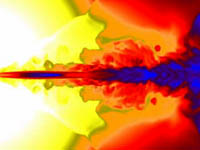Imagine the Universe News - 26 June 2003
Rosetta Stone Decodes Gamma-Ray Burst Mystery
| 26 June 2003 |
|
Scientists have pieced together the key elements of a gamma-ray burst, from star death to dramatic black hole birth, thanks to a "Rosetta stone" found on March 29, 2003.
This telling March 29 burst in the constellation Leo, one of the brightest and closest on record, reveals for the first time that a gamma-ray burst and a supernova -- the two most energetic explosions known in the Universe -- occur simultaneously, a quick and powerful one-two punch.
The results appear in the June 19, 2003 issue of Nature. The burst was detected by NASA's High-Energy Transient Explorer (HETE) and observed in detail with the European Southern Observatory's Very Large Telescope (VLT) at the Paranal Observatory in Chile.
"We've been waiting for this one for a long, long time," said Dr. Jens Hjorth, University of Copenhagen, lead author on one of three Nature letters. "The March 29 burst contains all the missing information. It was created through the core collapse of a massive star."
The team said that the "Rosetta stone" burst also provides a lower limit on how energetic gamma-ray bursts truly are and rules out most theories concerning the origin of "long bursts," which astronomers classify as those that last longer than two seconds.
A supernova is associated with the death of a star about eight times as massive as the Sun or more. Its core implodes, forming either a neutron star or (if there is enough mass) a black hole. The star's surface layers blast outward, forming the colorful patterns typical of supernova remnants. Scientists have suspected gamma-ray bursts and supernovae were related, but they have had little observational evidence, until March 29.
"The March 29 burst changes everything," said co-author Dr. Stan Woosley, University of California, Santa Cruz. "With this missing link established, we know for certain that at least some gamma-ray bursts are produced when black holes, or perhaps very unusual neutron stars, are born inside massive stars. We can apply this knowledge to other burst observations."
GRB 030329, named after its detection date, occurred relatively close, approximately 2 billion light years away (at redshift 0.1685). The burst lasted over 30 seconds. GRB 030329 is among the 0.2% brightest bursts ever recorded. Its afterglow lingered for weeks in lower-energy X-ray and visible light.
With the VLT, Hjorth and his colleagues uncovered evidence in the afterglow of a massive, rapidly expanding supernova shell, called a hypernova, at the same position and created at the same time as the afterglow. The following scenario emerged:
|
A bluish Wolf-Rayet star -- containing about 10 solar masses worth of helium, oxygen and heavier elements -- rapidly depleted its fuel, triggering the Type Ic supernova / gamma- ray burst event. The core collapsed, without the star's outer part knowing. A black hole formed inside surrounded by a disk of accreting matter, and, within a few seconds, launched a jet of matter away from the black hole that ultimately made the gamma-ray burst.
The jet passed through the outer shell of the star and, in conjunction with vigorous winds of newly forged radioactive nickel-56 blowing off the disk inside, shattered the star. Meanwhile, collisions among pieces of the jet moving at different velocities, all very close to light speed, created the gamma-ray burst. This "collapsar" model, introduced by Woosley in 1993, best explains the observation of GRB 030329, as opposed to the "supernova" and "merging neutron star" models.
|
"This does not mean that the gamma-ray burst mystery is solved," Woosley said. "We are confident that long bursts involve a core collapse, probably creating a black hole. We have convinced most skeptics. We cannot reach any conclusion yet, however, on what causes short gamma-ray bursts."
Short bursts might be caused by neutron star mergers. A NASA-led international satellite named Swift, to be launched in January 2004, will "swiftly" locate gamma-ray bursts and may capture short-burst afterglows, which have yet to be detected.
The VLT is the world's most advanced optical telescope, comprising four 8.2-meter reflecting Unit Telescopes and, in the future, four moving 1.8-meter Auxiliary Telescopes for interferometry. HETE was built by MIT as a mission of opportunity under the NASA Explorer Program, with collaboration among U.S. universities, Los Alamos National Laboratory, and scientists and organizations in Brazil, France, India, Italy and Japan.




